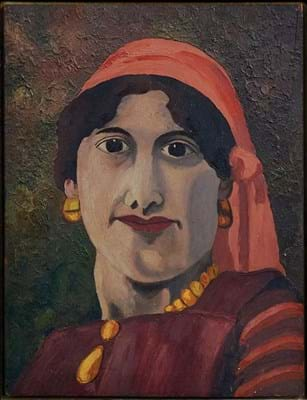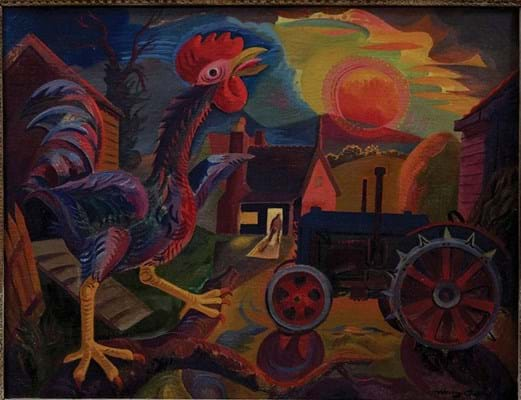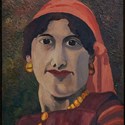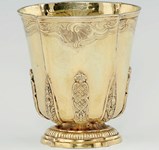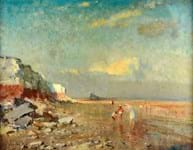Over the past four years, Daniel Wright, auctioneer at Colchester saleroom Reeman Dansie (20% buyer’s premium), has overseen biannual picture sales devoted to the region’s art.
The auctions, which cover mainly 19th-20th century material from the many schools, groups and traditions that make up the category, have become firm fixtures in the calendars of private collectors in particular.
“We have clients who collect with an idea of having a comprehensive collection of must-have East Anglian artists,” said Wright.
He lists several reasons for East Anglia’s rich artistic heritage. Its temperate climate and the intensity of its light – the closest the UK has to continental European light – makes it conducive to painting outdoors, while the landscape was left largely unspoilt by the industrial revolution.
“You also have a tradition of home-grown talent like Constable, Gainsborough, Seago, Munnings and now Maggi Hambling – a succession of really fine artists,” said Wright.
The broad choice on offer also means there is often something to suit every taste: “If you’re not into the Great Bardfield School then there is are Ipswich 19th century artists or the Norwich School.”
Collector snaps up Morris
The latest sale, comprising 286 lots of 19th and 20th century pictures, totalled around £100,000 with a high selling rate of 85%.
One of the leading lights of East Anglian 20th century art is Cedric Morris (1889-1982), the artist plantsman whose sought-after flower works have been commanding increasing sums at auction.
On offer at Reeman Dansie was an early portrait of an Arab woman painted in the Jardin d’Essai in Algeria when the artist was aged 32 and based in Paris.
The small 14 x 10½in (35 x 27cm) oil on board had impeccable provenance. It came to the vendor who was assistant gardener to Morris in the 1970s at Benton End House, the 16th century farmhouse on the outskirts of Hadleigh in Suffolk that doubled up as both art school and home. The picture had also been displayed at the Tate’s Cedric Morris exhibition in 1984.
Although the subject matter meant it was in a different commercial category to the artist’s flower paintings, this work tipped over top estimate to sell to ‘a significant collector’ of Morris’ work for £6600.
Collins crows
Among the eight lots by Henry Collins (1910-94), a founder of the Colchester Arts Society with Morris and John Nash, two stood out and achieved a possible artist record.
Crowing Cock (1946), an early 20in x 2ft 2in (51 x 67cm) oil on canvas knocked down to a UK private buyer at a multi-estimate £2500, and Folkestone Harbour (1956), a slightly larger 2ft 3in x 2ft 11in (70 x 90cm) oil on board, which had been exhibited at the Colchester Art Society and sold for £2200 against a £500-800 estimate. It would appear such sums represent a new high for the artist’s work at auction.
While Collins’ prices are not in the same league financially as his better-known colleagues from the society, this was proof his works are drawing stiffer competition at auction.
“Collins is very much coming of age, which is reflective of that wider mid-20th century trend,” said Wright. “He’s a really fine artist and is absolutely bound up in Colchester and the art school where he was a leading figure. Ten years ago, he was a very buyable artist and big works could be purchased in the low hundreds.”
A potential new record was also set for the artist’s wife, Joyce Pallot (1912-2004), whose 1958 oil on board of Hythe Quay in Maldon, Essex, took £800.
Hambling on the up
Another artist with a strengthening secondary market is the Suffolk-born painter Maggi Hambling (b.1945), an alumna of Morris’ East Anglian School of Art at Benton End House and the first artist-in-residence at the National Gallery in London.
“Hambling’s prices have come on significantly at auction and are much closer to retail prices than a lot of contemporary artists,” said Wright.
Four works in the sale came from the private collection of a local antiques dealer, offered with a range of furniture, silhouette art and traditional pictures.
Doing best was a typical portrait executed in Hambling’s distinctive energetic and vigorous style. The 21 x 17in (53 x 43cm) oil on canvas forms part of series of posthumous portraits Hambling made and depicts the colourful London artist Sebastian Horsley. It was purchased directly from the artist in 2012, the year it was painted.
Estimated at £1000-2000, it was knocked down to a UK private buyer at £6800. Also offered from the group was an exquisite oil on board of a curling wave, which measured just 6 x 7in (15 x 18cm). It found a buyer at nearly double the top estimate at £2000.
Popular animal painter
Completing a well-rounded offering of East Anglian art was a work by the popular animal painter John Vine of Colchester (1809-67), which was described by Wright as an appealing blend of “naïve charm and Vine’s obvious painterly ability”.
Painted before 1840, the 12½ x 17in (32 x 43cm) oil on canvas of a bay horse and black pony before a gate had passed by descent from the original owner, a Mr William May who had resided at Covenbrook Hall Garden depicted in the picture. It sold to a local collector for £3900 against a £1500-2000 estimate.
Vine – born with a genetic disorder that resulted in him having malformed arms and only a few fingers – has a devoted following at auction from the UK to North America, which is a big source for buyers of naïve animal pictures.



